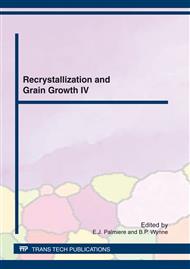p.367
p.373
p.374
p.380
p.387
p.393
p.399
p.407
p.415
Thermal Behavior of Nickel Deformed to Ultra-High Strain by High Pressure Torsion
Abstract:
Polycrystalline Ni (99.5 %) has been deformed to an ultra-high strain of εvM=100 (εvM, von Mises strain) by high pressure torsion (HPT) at room temperature. The deformed sample is nanostructured with an average boundary spacing of 90 nm, a high density of dislocations of >1015m-2 and a large fraction of high angle boundaries (>15o) 68% as determined by transmission electron microscopy and 80% as determined by electron backscatter diffraction. The thermal behavior of this nanostructued sample has been investigated by isochronal annealing for 1h at temperatures from 100 to 600°C, and the evolution of the structural parameters (boundary spacing, average boundary misorientation angle and the fraction of high angle boundaries), crystallographic texture and hardness have been determined. Based on microstructural parameters the stored energy in the deformed state has been estimated to be 24 MPa. The isochronal annealing leads to a hardness drop in three stages: a relatively small decrease at low temperatures (recovery) followed by a rapid decrease at intermediate temperatures (discontinuous recrystallization) and a slow decrease at high temperatures (grain growth). Due to the presence of a small amount of impurity elements, the recovery and recrystallization are strongly retarded in comparison with Ni of high purity (99.967%). This finding emphasizes the importance of alloying in delaying the process of recovery and recrystallization, which enables a tailoring of the microstructure and properties through an optimized annealing treatment.
Info:
Periodical:
Pages:
387-392
Citation:
Online since:
April 2012
Authors:
Price:
Сopyright:
© 2012 Trans Tech Publications Ltd. All Rights Reserved
Share:
Citation:


